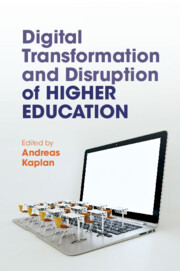Book contents
- Digital Transformation and Disruption of Higher Education
- Digital Transformation and Disruption of Higher Education
- Copyright page
- Contents
- Figures
- Tables
- Contributors
- Preface
- Chapter 1 Nothing Is Constant Except Change
- Part I (R)evolution of the Higher Education Sector
- Part II Changes in Teaching Formats
- Part III Changes in Teaching Content
- Part IV Networking and Social Activities
- Part V Certification and Diplomas
- Part VI Careers and Professionalisation
- Part VII Futuristic and Ultramodern Higher Education
- Chapter 27 Learning Analytics Enriched by Emotions
- Chapter 28 Personal Analytics in the Science of Learning
- Chapter 29 The AI Economy and Higher Education
- Part VIII Higher Education in Motion
- Editor’s Biography
- Index
- References
Chapter 27 - Learning Analytics Enriched by Emotions
from Part VII - Futuristic and Ultramodern Higher Education
Published online by Cambridge University Press: 09 June 2022
- Digital Transformation and Disruption of Higher Education
- Digital Transformation and Disruption of Higher Education
- Copyright page
- Contents
- Figures
- Tables
- Contributors
- Preface
- Chapter 1 Nothing Is Constant Except Change
- Part I (R)evolution of the Higher Education Sector
- Part II Changes in Teaching Formats
- Part III Changes in Teaching Content
- Part IV Networking and Social Activities
- Part V Certification and Diplomas
- Part VI Careers and Professionalisation
- Part VII Futuristic and Ultramodern Higher Education
- Chapter 27 Learning Analytics Enriched by Emotions
- Chapter 28 Personal Analytics in the Science of Learning
- Chapter 29 The AI Economy and Higher Education
- Part VIII Higher Education in Motion
- Editor’s Biography
- Index
- References
Summary
There is no doubt that students’ emotional states influence their general well-being and their learning success. Although current advances of computer hardware and Artificial Intelligence (AI) techniques made it possible to include real-time emotion-sensing as one of the ways to improve students’ learning experience and performance, there are many challenges that might inhibit or delay the deployment and usage of emotional learning analytics (LA) in education. In this chapter, we will critically review the current state-of-the art of emotion detection techniques, analysis and visualisation, the benefits of emotion analysis in education and the ethical issues surrounding emotion-aware systems in education. Finally, we hope that our guidelines on how to tackle each of those issues can support research in this area.
Keywords
- Type
- Chapter
- Information
- Digital Transformation and Disruption of Higher Education , pp. 361 - 376Publisher: Cambridge University PressPrint publication year: 2022

